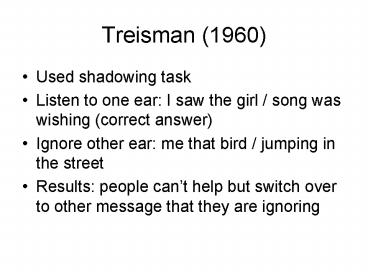Treisman (1960) - PowerPoint PPT Presentation
1 / 16
Title: Treisman (1960)
1
Treisman (1960)
- Used shadowing task
- Listen to one ear I saw the girl / song was
wishing (correct answer) - Ignore other ear me that bird / jumping in the
street - Results people cant help but switch over to
other message that they are ignoring
2
Interpretation of results
- Support late selection ? people were processing
the meaning of the ignored message
3
Recent selection model
- Pashler (1998) (p. 65)
- Both early and late selection occur
- Early selection is done in a bottleneck-like
fashion (some material is completely shut out) - Late selection done through capacity sharing ?
split capacity to process multiple messages
4
Generality of selective attention concepts
- Shadowing experiments involve auditory
information - But, similar concepts and theories for visual
information, as well
5
Information Processing Model
SENSORY STORE (e.g, ICON)
STM
SENSATION
PERCEPTION
ATTENTION
6
Short-term Memory
- Aka, the short-term store (old-fashioned)
- Aka, working memory (temporary storage of
information to do a task) - Aka, short-term working memory
- Aka, primary memory (James)
7
Try these math problems
- 4 X 9 _____? Answer 36 (remember directly,
dont have to figure out) - 35 X 8 ______? Answer 280 (you computed this
in your head) - 261 X 97 ______? Answer 25,317 (very very
difficult to do in your head) - Problem -gt information gets jumbled in your head
8
Interpretation
- There is a limit on how much information we can
keep track of in our heads at a time (aka, a
capacity limit) - Capacity limit is related to your short-term
memory (in other words, your short-term has a
limited capacity for holding information)
9
How much does STM hold?
- Use digit span task
- Hear a list of random digits (single digits)
- Repeat back in order
- E.g., 4 8 1 3 5
- Gradually increase the length of the list
- Keep going until you make mistakes
- Commonly between 4 and 10 digits
10
interpretation
- Your digit span number of digits that you can
repeat back without mistakes - Conclusion can hold only a little bit of
information in short-term memory at a time
11
Capacity of STM
- Are multiple methods for measuring capacity of
STM - But estimates are always comparable
- Miller analyzed numerous tasks to estimate STM
capacity ? 7 /- 2 - Can hold 7 /- 2 items in STM
- chunk ? the item in STM can be an individual
item or can be a meaningful chunk of items
12
- In digit span task, use individual digits (e.g.,
1) - Alternatively could use letters, (now called
letter span task) ? spans in same range as digits - Alternatively, could use words (e.g., milk eggs
celery chicken etc.) (now called word span task)
? same results
13
- But, one word is composed of several letters, so
7 /- 2 words is many more letters than 7 /- 2
letters - What you are remembering is chunksnot individual
letters - Chunk meaningful unit
14
3 things to know about a memory structure
- Capacity how much it can hold
- Duration how long information is held
- Sensory memory ? less than 1 second
- STM ? up to 30 seconds
- Code (or Format) the way in which information
is held in memory
15
Different codes
- Reflect how your mind stores information in
memory (similar to computer using 1s and 0s) - General possibilities
- Acoustic code information stored in terms of
how it sounds - Visual code in terms of looks
- Other codes tied to senses olfactory (smell),
tactile (touch), gustatory (taste)
16
More on codes
- Semantic code refers to the meanings of things
- E.g., letter span task, hear the letter C
- Acoustic code for C see
- Visual code for C C (what it looks like)
- Semantic code for C 3rd letter of alphabet
average grade

